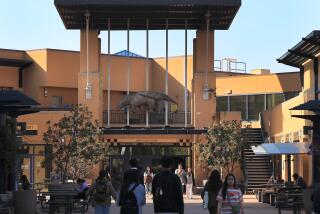Cal State announces plans for fall 2021 reopening of its 23 campuses

Six days before its application window closes, the California State University system serving nearly half a million students has announced a plan for all 23 of its campuses to reopen next fall after more than a year of virtual instruction amid the COVID-19 pandemic.
The early announcement is aimed at helping students and families as they plan for next year — and as they decide whether to apply to Cal State, university leaders said.
“We want to return as much as we can to the in-person university,” Chancellor Timothy P. White said in an interview. “We want our students who are applying currently … to know what our plans are.”
“This decision comes at a good time as high school and transfer students have until Dec. 15 to complete their applications for fall admission,” Chancellor-select Joseph I. Castro, who takes over in January, said in a statement. “I urge eligible students across the Golden State to apply for admission to one or more CSU campuses.”
In May, the nation’s largest four-year university system similarly came out early with a plan for fall semester — except it was to announce the move to offer almost all-virtual instruction.
Despite that decision, overall enrollment at the university surged to a record high this fall, surpassing 485,000 students. But the number of first-time freshmen dropped significantly, and enrollment also fell at some Northern California campuses, following trends from previous years.
Those latter drops were likely on university officials’ minds as they weighed options for next year.
Already the Cal State system has extended its application deadline for students planning to enter in fall 2021 by 11 days, to Dec. 15. Officials have said that they wanted to ease the burden on students who had experienced challenges as a result of the pandemic and ensure that the deadline was not a barrier to applications.
Some high school counselors and students have predicted a drop-off in applications, especially among low-income and first-generation students who have pressing financial and family concerns to attend to and who lack the resources at home to apply on their own.
White said he had noticed a slight increase in the number of “in-progress” applications to Cal State campuses — applications that potential first-time and transfer students have begun but not yet completed.
“It could simply be that they’re busy, or they’re waiting” until the deadline — but it could also be that they’re hesitating, White said. He wanted to provide students some certainty about what next fall would look like.
“California can ill-afford to lose a generation of students…. I want to turn every stone to make sure that those individual students keep their doors open for their future,” White said, adding that application fee waivers and “robust financial aid” are available to students who are experiencing financial difficulties.
The Cal State system will be offering primarily virtual instruction for the rest of the academic year amid a statewide surge in cases. But White, whose academic background is in the life sciences, said that current research and promising news about a vaccine gave him the confidence to make a different decision for eight months from now.
He said he has always been guided by the “twin north stars” of ensuring the health and safety of campus communities and advancing students’ progress to degrees.
“And if things change, the university will be nimble,” he said.
Cal State systemwide academic senate chair Robert Keith Collins said White consulted with him ahead of the announcement, and that Collins relayed the faculty’s concerns about an in-person return. Those included questions about how the university would limit the risk of transmission if herd immunity hasn’t been achieved, protocols to enforce mask-wearing and vaccination, procedures for dealing with any individuals who are opposed to receiving a vaccine, and the cost burden of such a return.
“It really is important for faculty to know this is going to be a safe environment,” Collins said.
He added that older faculty, those at higher risk of complications from the virus, and those living in multi-generational households should be given the option of working remotely until herd immunity is achieved.
Charles Toombs, president of the California Faculty Assn., the union that represents Cal State faculty, said in a statement that the association was “disappointed” it was not consulted prior to the announcement, but that it was “cautiously optimistic” about a safe return to campus next fall.
“There are positive indicators that the U.S. will gain a better handle on COVID-19 by fall 2021, including the impending distribution of a vaccine and the election of a new leader of federal efforts,” Toombs said.
Zahraa Khuraibet, president of the Cal State Students’ Assn., said she was grateful the chancellor’s office came out early with a plan for next year, as students had requested.
“I at least feel comfortable that the decision is going to be based on science,” she said. “I’m happy that there’s some hope for us.”
More to Read
Start your day right
Sign up for Essential California for news, features and recommendations from the L.A. Times and beyond in your inbox six days a week.
You may occasionally receive promotional content from the Los Angeles Times.







